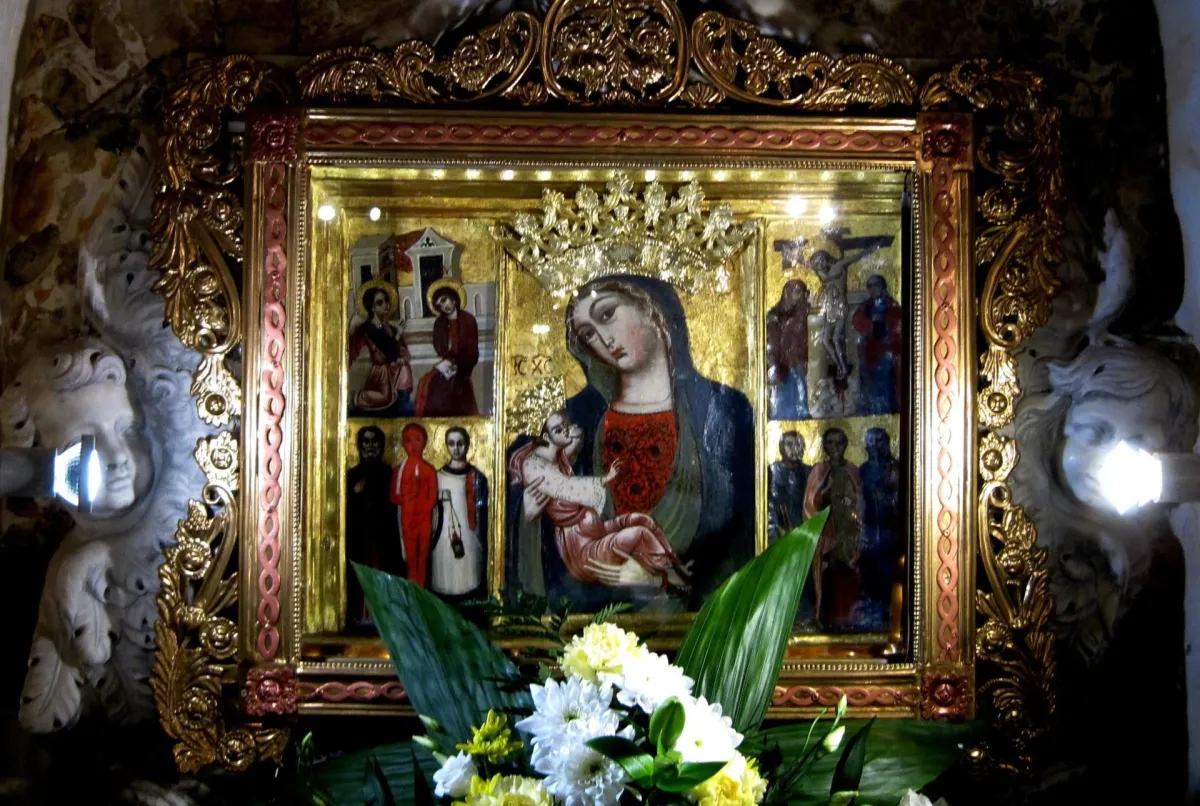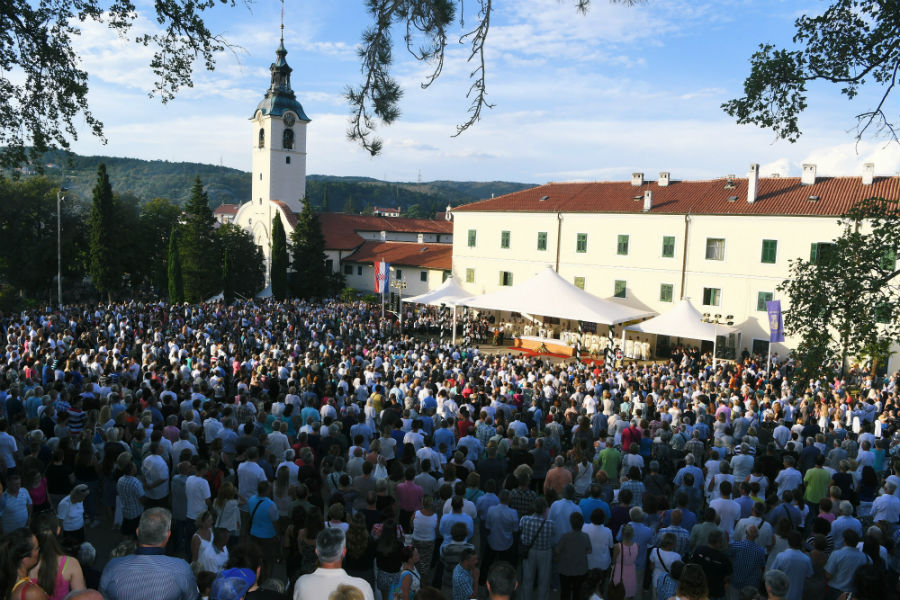
The Magic of Vela Gospa: A Guide to Croatia’s Pilgrimage Traditions, Celebrations, and Language
Vela Gospa Essentials
Date: August 15 — national public holiday in Croatia.
Scope: Celebrations centre on the day itself, but pilgrimages and novenas often begin days earlier.
Closures: Shops, offices, and banks closed; tourist sites may have shorter hours.
Travel: Book transport and accommodation early in pilgrimage towns like Sinj, Marija Bistrica, and Trsat.
Celebrations: Processions, pilgrimages (on foot, barefoot, or on knees), open-air masses, folk music, flower petals, and traditional dress.
Etiquette: In pilgrimage towns, dress respectfully; greet with Sretan blagdan Velike Gospe!
Language tip: Learn the words for what you’ll see — procesija (procession), hodočašće (pilgrimage), svetište (shrine), misa (Mass).

Vela Gospa in Sinj; Source: Pixell/Author: Ivo Čagalj/PIXELL
Picture this…
A soft August dawn in Sinj. The air is cool enough to carry the smell of pine from the nearby hills. Cannons (mačkule) thunder from the fortress above, echoing off the stone streets. The first Mass has already been said at 4 a.m., the next at 7, and the Miraculous Madonna — robed in silk and flowers — is lifted high on the shoulders of the Alkari knights.
Along the route, petals fall from windows, drifting down onto the heads of pilgrims who have been walking all night. Some barefoot, some on their knees, they pray aloud, the words rolling in a cadence as old as the town itself. Choirs swell, rosaries click, and the rhythm of Croatian — its accents, its music — is everywhere.
This is Vela Gospa — the Feast of the Assumption of Mary — a tradition that blends centuries of faith, history, and community.
A Short History of Vela Gospa | Kratka povijest Velike Gospe
Vela Gospa is both a deeply Catholic feast and a cultural cornerstone. In Croatia, August 15 marks not only the Assumption of Mary into heaven, but also the height of summer’s communal life. Pilgrimage routes, some dating back to medieval times, fill with people days before the feast.
Some shrines, like Marija Bistrica in Hrvatsko Zagorje, have been centres of Marian devotion for centuries, crowned as the “Queen of Croatia” and visited by Popes. Others, like Trsat in Rijeka, are tied to legends of the Holy House of Nazareth. In Sinj, the Madonna is linked to the 1715 victory over Ottoman forces — believed by locals to be granted through her intercession.
The feast has always been about more than religion. It’s about identity, belonging, and the ties between language, land, and people.

Vela Gospa in Trsat, Rijeka
How Croatia Celebrates Today | Kako se danas slavi Vela Gospa
From coastal towns to inland valleys, the celebration is a mix of devotion and community. In the days before, you might see groups of pilgrims walking along rural roads, carrying banners and singing hymns. On the day itself:
In Sinj, tens of thousands fill the square for the main Mass before following the Madonna through the streets.
At Marija Bistrica, candlelight processions snake through the hills, the basilica lit like a jewel.
In Trsat, the climb up the Petar Kružić staircase is itself an act of prayer.
Across the country, smaller shrines like Vepric, Aljmaš, Gospa od Zečeva, and Gospa od Prizidnice draw thousands to their own processions and open-air Masses.
Everywhere, you’ll hear Croatian spoken in its most natural form: in the rhythm of the rosary, the melody of Marian hymns, and the call-and-response of liturgy.
Is Vela Gospa a Good Time to Visit Croatia? | Posjetiti Hrvatsku za Veliku Gospu?
It depends on what you seek.
The beauty:
You’ll witness Croatia at its most heartfelt, with traditions that have survived centuries. Pilgrimage towns brim with colour, sound, and history.
The challenges:
It’s busy. Accommodation in pilgrimage centres books months ahead. Roads can be crowded with pilgrims. Many shops and services outside tourist zones close.
💡 Tip: If you want to experience the day but avoid the densest crowds, visit smaller shrines like Trški Vrh or Molve — the devotion is just as deep, but the pace is gentler.
Where and How to Spend Vela Gospa | Gdje i kako provesti Veliku Gospu
Sinj — For the full spectacle: early morning Mass, Alkari-led procession, cannons, and petals.
Marija Bistrica — For candlelit processions and rolling green hills.
Trsat — For the climb and sweeping views over Rijeka and the sea.
Vepric (Makarska) — For a quiet, Lourdes-like grotto set in stone.
Aljmaš — For riverside devotion along the Danube.
Gospa od Prizidnice (Čiovo Island) — For a hermitage clinging to the cliffs above the Adriatic (video below)
Each offers its own rhythm and its own language of celebration.
Vela Gospa Vocabulary | Rječnik Velike Gospe
procesija — procession
hodočašće — pilgrimage
svetište — shrine
misa — Mass
oltar — altar
kip — statue
krunica — rosary
vjernici — faithful
pjesma — song/hymn
Language, Culture, and Your Voice in Croatian
Standing in a Croatian square on Vela Gospa, you don’t just hear words — you hear music. The rise and fall of accents, the way syllables stretch or shorten, the melody of voices praying together.
That’s why, in my 4-Pillar Method of teaching Croatian — grammar, vocabulary, pronunciation, culture — pronunciation is the bridge that brings everything alive. Without it, you can know the words but miss the heart.
Bring the Music of Croatian Into Your Voice — Starting Now
Whether this is your first visit here or you’ve been reading my work for a while, I want to make sure you know about a free resource I created to help every learner take a huge step forward in speaking Croatian naturally.
It’s called Master Croatian Pronunciation – Understanding Stress, and it’s a free Masterclass + PDF Guide designed to help you:
Understand why Croatian stress is so essential to being understood (and sounding authentic)
Recognise and use the four types of Croatian stress
Hear how stress can change the meaning of words entirely
Train your ear to catch these patterns in real speech so you can reproduce them with confidence
The PDF is your reference guide, the audio links let you hear and imitate native examples, and the video lesson ties it all together so you’re not just learning rules — you’re feeling the rhythm and melody of Croatian.
📥 Download it here: https://talktimecro.com/accent-freebie
Because just like the bells, petals, and hymns of Vela Gospa carry meaning through their sound, so does every Croatian word you speak. Let yours carry the right melody.
Sretan blagdan Velike Gospe — and may your next steps in learning Croatian carry the same rhythm and joy as the processions that will fill our streets tomorrow.
